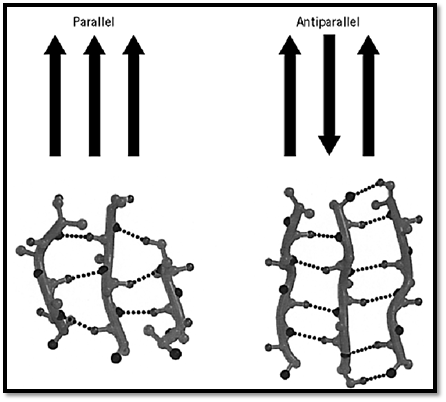


 النبات
النبات
 الحيوان
الحيوان
 الأحياء المجهرية
الأحياء المجهرية
 علم الأمراض
علم الأمراض
 التقانة الإحيائية
التقانة الإحيائية
 التقنية الحيوية المكروبية
التقنية الحيوية المكروبية
 التقنية الحياتية النانوية
التقنية الحياتية النانوية
 علم الأجنة
علم الأجنة
 الأحياء الجزيئي
الأحياء الجزيئي
 علم وظائف الأعضاء
علم وظائف الأعضاء
 الغدد
الغدد
 المضادات الحيوية
المضادات الحيوية|
Read More
Date: 16-5-2016
Date: 6-6-2021
Date: 22-12-2015
|
Beta-Sheet
The b-sheet is a secondary structure component of protein structure, comprising two or more adjacent b-strands linked by hydrogen bonds. In contrast to the coiled backbone of the a-helix, the structure of a b-strand is characterized by an extended backbone conformation, corresponding to the favorable upper left region of the Ramachandran Plot. b-Sheets are formed by a side-by-side arrangement of b-strands, with backbone hydrogen bonds between adjacent strands linking the sheet together. The side chains of consecutive residues on a b-strand do not interact with each other, but lie alternately above and below the sheet, giving a pleated appearance to the b-sheet backbone (the b-sheet is sometimes referred to as a b-pleated sheet).
b-Strands are often depicted as arrows in protein structure diagrams, with the direction of the arrow running from the N-terminal end to the C-terminal end of the b-strand. When packed together in a b-sheet, the b-strands may all be oriented in the same direction (parallel b-sheet) or in alternating directions (antiparallel b-sheet). In some cases, the b-strands will be a mixture of parallel and antiparallel (mixed b-sheet). The backbone hydrogen bonding patterns of parallel and antiparallel b-sheet structures differ (Fig. 1). In the parallel b-sheet, hydrogen bonds are evenly spaced along the b-strand and point at an angle to the other strand. The antiparallel b-sheet has alternately wide and narrow spacings between adjacent hydrogen bonds. The average backbone angles for parallel and antiparallel b-sheets also vary, with f of –119° and Y of 113° for parallel structures and f of –139° and Y of 135° for antiparallel structures. Most b-sheets have a right-handed twist of about 10°. The regular hydrogen bonding pattern and backbone angles of b-sheets are sometimes disrupted at the edges by the formation of a b-bulge, accentuating the twist to 35° to 45°.

Figure 1. b-Sheet structure in proteins. Schematic representation of parallel and antiparallel b-sheets, with each strand of the sheet depicted as an arrow having direction from the N-terminal to the C-terminal end. In the lower half of the figure, the atomic detail of the b-sheet structure is shown, with hydrogen bonds between backbone carbonyl oxygen atoms and amide nitrogen atoms indicated by dotted lines. Note the approximately equal spacing of hydrogen bonds in the parallel b-sheet compared with the alternating wide and narrow spacing in the antiparallel b-sheet. For clarity, only Cb atoms of side chains are shown. Nitrogen atoms and oxygen atoms are shown as dark spheres. This figure was generated using Molscript (1) and Raster3D (2, 3).
Because a b-sheet can be formed from sections of polypeptide chain that are distant from each other in the primary structure, many different types of b-sheet have been identified in protein structures. The b-meander is a simple antiparallel b-sheet topology where b-strands that are consecutive in sequence are also located adjacent to one another in the three-dimensional structure. The adjacent b-strands in a b-meander are often connected by hairpin turns. Other types of antiparallel b-sheet structure include the jelly roll motif, the Greek key motif, and the b-barrel. The b-helix is formed from parallel b-sheets.
References
1.P. J. Kraulis (1991) J. Appl. Crystallogr. 24, 946–950.
2.E. A. Merritt and M. E. P. Murphy (1994) Acta Crystallogr. D50, 869–873.
3. D. J. Bacon and W. F. Anderson (1988) J. Mol. Graphics 6, 219–222.



|
|
|
|
إجراء أول اختبار لدواء "ثوري" يتصدى لعدة أنواع من السرطان
|
|
|
|
|
|
|
دراسة تكشف "سببا غريبا" يعيق نمو الطيور
|
|
|
|
|
|
اللجنة التحضيرية للمؤتمر الحسيني الثاني عشر في جامعة بغداد تعلن مجموعة من التوصيات
|
|
|
|
السيد الصافي يزور قسم التربية والتعليم ويؤكد على دعم العملية التربوية للارتقاء بها
|
|
|
|
لمنتسبي العتبة العباسية قسم التطوير ينظم ورشة عن مهارات الاتصال والتواصل الفعال
|
|
|
|
في جامعة بغداد.. المؤتمر الحسيني الثاني عشر يشهد جلسات بحثية وحوارية
|